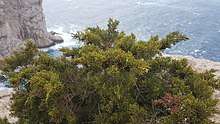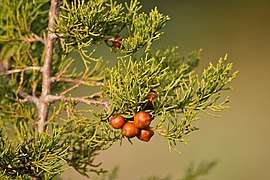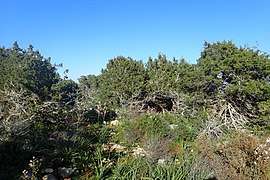Juniperus turbinata
Juniperus turbinata is a woody plant in the family Cupressaceae.[1] The species was previously treated as part of Juniperus phoenicea, which is now regarded as restricted to Portugal, Spain and France, whereas J. turbinata is found from Macaronesia throughout the Mediterranean to the Arabian Peninsula.
| Juniperus turbinata | |
|---|---|
 | |
| Capo Caccia, Sardinia | |
| Scientific classification | |
| Kingdom: | Plantae |
| Clade: | Tracheophytes |
| Division: | Pinophyta |
| Class: | Pinopsida |
| Order: | Pinales |
| Family: | Cupressaceae |
| Genus: | Juniperus |
| Section: | Juniperus sect. Sabina |
| Species: | J. turbinata |
| Binomial name | |
| Juniperus turbinata Guss.[1] | |
| Synonyms[1] | |
| |
Description
Juniperus turbinata resembles J. phoenicea. It is a shrub or small tree up to 8 m (26 ft) in height. The smaller branches have reddish bark. The adult leaves are scale-like, closely pressed to the twigs. Pollen is produced in the autumn (October to November), rather than in spring as in J. phoenicea. The seed cones are 7–11 mm (0.3–0.4 in) long (longer than in J. phoenicea), and somewhat elongated, especially when immature. Each cone typically has seven to nine seeds (fewer than J. phoenicea).[2][3]
 Foliage and cones
Foliage and cones In maquis shrubland habitat
In maquis shrubland habitat
Taxonomy
Juniperus turbinata was first described by Giovanni Gussone in 1844. It has been treated as a variety or subspecies of Juniperus phoenicea.[1] Plants occurring in the Canary Islands have been treated as a separate species, Juniperus canariensis.[3][1] DNA from populations previously assigned to J. phoenicea var. phoenicea and J. phoenicea var. turbinata was studied in 2013. It was found that the two taxa were clearly separated, and hence best treated as two species. No significant difference was found between Canary Island populations and other populations of J. turbinata.[2]
Distribution and habitat
Juniperus turbinata has a native distribution from Macaronesia throughout the Mediterranean to the Arabian Peninsula. It is known from southwestern and southeastern Europe, North Africa, the Canary Islands and Madeira, and parts of western Asia and the Arabian Peninsula (Cyprus, the east Aegean Islands, Lebanon and Syria, the region of Palestine, the Sinai Peninsula and Saudi Arabia).[1] It favours soils that are composed of sand, Cambrian limestone or volcanic rock.[2]
References
- "Juniperus turbinata", World Checklist of Selected Plant Families, Royal Botanic Gardens, Kew, retrieved 2018-01-28
- Adams, Robert; Boratyński, Adam; Arista, Montserrat; Schwarzbach, Andrea; Leschner, Hagar; Liber, Zlatko; Minissale, Pietro; Mataraci, Tugrul & Manolis, Avramakis (2013), "Analysis of Juniperus phoenicea from throughout its range in the Mediterranean using DNA sequence data from nrDNA and petN-psbM: The case for the recognition of J. turbinata Guss.", Phytologia, 95 (2): 202–209
- Bramwell, David & Bramwell, Zoë (2001), Wild Flowers of the Canary Islands (2nd ed.), Madrid: Editorial Rueda, p. 104, ISBN 84-7207-129-4